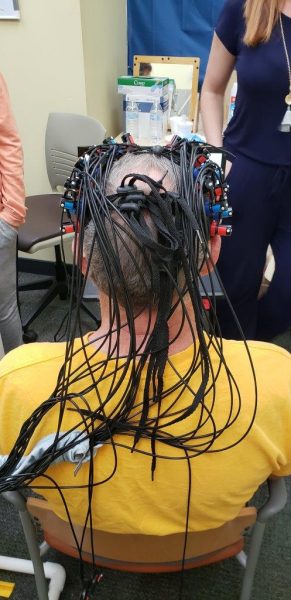Summer citizens pay it forward in experiments
This article was submitted by Maureen and Dave DeFrance. The couple are some of Logan’s Summer Citizens.
Did you know there is an entity within Utah State University that allows you to “pay it forward” by helping discover ways to improve your quality of life while recovering from injury or aging? The Kinesiology and Health Science Department focuses on some of the common maladies we are faced with during illness or as we age such as balance, memory retention, multi tasking, or loss of body function. Both my husband and I participated in several experiments to help gather data for studying deteriorating responses of the human brain.
Recently, we participated in such an experiment. Many people that have radiation to their neck area have great difficulty in swallowing. The Science department is mapping the brain response to imagined virtual swallowing vs. actual swallowing to assist radiation patients in recovering their swallowing ability. The process involved getting connected to a brain activity network, receiving various instructions to imagine activities such as hard swallowing, controlling your Adams apple, and repeated swallowing (they are very interested in testing left handed people like myself). These imagined tasks were intermingled with real activities such as repeated swallowing of water through a straw or via an eye dropper. The brain’s response was then mapped to determine the best imagined exercise to stimulate recovery of the swallowing function (An analogy of this is a basketball player imagining that he/she is shooting a ball and hitting the basket).

I participated in a study that examined how our sense of balance contributes to walking stairs (I get dizzy on a merry go round). How does this balance change as we age? When older people fall, many end up wheelchair bound. Are there ways to help diminish these aging changes? Mapping brain activity in healthy individuals is the first step to finding ways of combatting a deteriorated reaction. After being outfitted with electrodes to my legs and head, I was guided to walk up a set of stairs, then down another set of stairs. An external magnetic pulse was delivered to my ear/brain to throw off my balance while descending the stairs (Picture 4). The team monitored my brain’s reaction to the stimulus that forced this unstable condition. How did my brain process this imbalance? How did my muscles counteract a possible fall? Analysis of these results is ongoing.
Another experiment that is in the final analysis stage is a study to improve cognitive function through computer games. These games tap into memory, eye/hand coordination, and logical problem solving. Can aging brains be kept more viable? Can brains be “trained” to arrest their aging, or even to improve? This may help stroke patients, Parkinson’s victims, or people with other age related deficits.
 I queried the experimenters about the validity of having Summer Citizens in Logan as volunteers for these studies. After all, we represent a skewed population of pretty healthy individuals. The answer was surprising. I was told that Summer Citizens are a GOOD target group. Generally, we represent a healthy aging process, and that is a big strength of these studies. There are many simultaneous experiments throughout the department and throughout the year. Subjects are being sought, and they could use more seniors as well as those in their 20s, 30s, 40s, and 50s. Ask your friends and relatives. I learned a lot about ongoing research and met some dedicated researchers. It was quite an experience, and a great way to pay it forward for the future. If you are interested in volunteering, please contact any of the following people in the Kinesiology and Health Science Department at Utah State University.
I queried the experimenters about the validity of having Summer Citizens in Logan as volunteers for these studies. After all, we represent a skewed population of pretty healthy individuals. The answer was surprising. I was told that Summer Citizens are a GOOD target group. Generally, we represent a healthy aging process, and that is a big strength of these studies. There are many simultaneous experiments throughout the department and throughout the year. Subjects are being sought, and they could use more seniors as well as those in their 20s, 30s, 40s, and 50s. Ask your friends and relatives. I learned a lot about ongoing research and met some dedicated researchers. It was quite an experience, and a great way to pay it forward for the future. If you are interested in volunteering, please contact any of the following people in the Kinesiology and Health Science Department at Utah State University.
Dr. Stephanie Knollhoff (435) 797-4113
Dr. David Bolton (435) 797-7329
Dr. Chris Dakin (435) 797-7324
Maureen and Dave DeFrance
Summer Citizens from Millennial Towers

